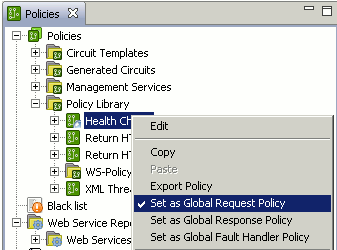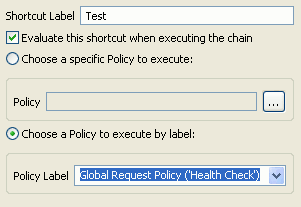Contents
Global policies enable you to label policies with specific roles in the API Gateway configuration. For example, you can label a specific policy such as XML Threat Policy as a Global Request policy. This policy can be executed globally on the request path for all messages passing through the API Gateway. Using a global policy in this way enables you to use the same policy on all requests, and for multiple services. It also means that you can change the labeled global policy to a different policy without needing to rewire any existing policies.
For example, using a Policy Shortcut Chain filter in a policy enables you to delegate to one or more policies to perform specific tasks, before continuing execution of the remaining filters in the current policy. Using this approach to encapsulate specific functionality in a policy facilitates modularity and reusability when designing API Gateway policies. This enables you to build up a policy library of reusable routines over time.
Each shortcut in a Policy Shortcut Chain points to a specific policy, which is called at each point in the execution chain. However, consider a policy whose role is to be called first in all message handling contexts before any context-specific policies are run, and call this the run-first role. To realize this, you must create a Policy Shortcut Chain with a link to the run-first policy as its first entry, the context-specific policy as its second link, and so on.
One of the shortcomings of this approach is that if you have set up a large number of Policy Shortcut Chain filters, each calling the run-first policy, and you need to change the run-first policy globally, you must update each Policy Shortcut Chain filter individually to point to the newly designated run-first policy. Similarly, if you wish to ignore the run-first Policy globally, you must remove the first entry in each filter.
Global policies enable you to label a specific policy in terms of its role. You can delegate to the policy using its label instead of a specific link to the policy. This indirection using a label makes it very easy to globally change which policy is delegated to, merely by moving the label from one policy to another. Each filter that refers to the policy using its label now resolves the label to the new policy without needing to change the filter configuration. Similarly, if the label is not applied to a specific policy, nothing is executed for this link.
The following global policy roles have a reserved label and a specific meaning in the API Gateway policy framework:
| Role | Label | Description |
| Global Request Policy | system.policy.request |
Executed globally for all messages passing through the API Gateway on the request path. |
| Global Response Policy | system.policy.response |
Executed globally for all messages passing through the API Gateway on the response path. |
| Global Fault Handler Policy | system.policy.faulthandler |
If any policy aborts during execution, or a top-level policy fails and has not specified a Fault Handler filter, this policy is executed instead of the internal SOAP Fault filter. |
You can select specific policies with these roles under the Policies node in the Policy Studio tree. You can then create links to these roles when creating a Policy Shortcut Chain. These steps are explained in the next sections.
To select a global policy, right-click a policy under the Policies node, and select one or more global policies (for example, Set as Global Request Policy, Set as Global Response Policy, or Set as Global Fault Handler Policy). These policies are executed globally for all messages passing through the API Gateway.
The following example shows the XML Threat Policy set as the Global Request Policy. The policy node labeled for the specific role is displayed with a globe icon:
 |
When you have selected the policy for a specific role, you can then reference the labeled policy in a Policy Shortcut Chain filter, or at the service level in a Relative Path or Web Service Resolver. Referencing a labeled policy is different from referencing a specific policy directly. Referencing a policy directly involves selecting a specific policy to execute in the chain. Referencing a labeled policy means selecting a filter by its label only.
The main advantage of this approach is that you can configure a policy to run in a policy shortcut chain in a specific role, and then select a different policy as the global policy for that role. All references to the global policy label in the various shortcut chain filters are changed to use the newly selected policy, without requiring you to modify each policy shortcut chain filter individually to explicitly point to a different policy.
Selecting another policy in a global role deselects the previously selected policy. The following example shows the Health Check set in the global role, and the XML Threat Policy policy is no longer selected:
 |
![[Important]](../common_oracle/images/admon/important.png) |
Important |
|---|---|
|
You can not select a policy for a specific role if, in doing so, you create a loop in the policies. For example, if a Policy Shortcut Chain filter has a reference to a labeled policy, and the filter’s parent policy is marked as the labeled policy, the filter would call back to itself in a loop. This error is caught, and a trace line is output to the Policy Studio Console view. |
When adding a policy shortcut in a Policy Shortcut Chain filter, you can select to call a labeled policy instead of selecting a specific policy. The following example from the Add a new Shortcut to a Policy dialog shows adding a shortcut to the Global Request Policy (Health Check) policy label:
 |
Then if you select a different policy as the request policy in the Policy Studio tree, when you subsequently view this shortcut in the chain filter, you see that the details for the shortcut have changed. The following example from the Edit the Shortcut to the Policy dialog shows the policy label changed to Global Request Policy (XML Threat Policy).
 |
For more details on configuring these screens, see the Policy Shortcut Chain filter.
![[Important]](../common_oracle/images/admon/important.png) |
Important |
|---|---|
|
If you remove a label from a policy by deselecting it in the Policy Studio tree, any reference to that labeled policy is not called when evaluating the shortcut in the chain, irrespective of whether the Evaluate this shortcut when executing the chain checkbox is selected (the Active status column in the table view). This corresponds with the behavior for a specific policy in the chain. If a link to a policy is not set for a shortcut, the link is not evaluated. |
In this example, the table shows that the shortcut is configured to point to the labeled policy, but the label does not resolve to a policy (for example, it is unspecified because there is no policy in the specified role):
 |
Under the Listeners node, you can also configure global policies at the
service level to run on a specific Relative Path or Web Service Resolver when messages are
received by the API Gateway. A Relative Path binds a policy to a specific relative path
location (for example /healthcheck). A Web Service Resolver maps messages
destined for a specific Web Service to a Service Handler or Web
Service Filter.
You can configure a global policy at the service level to run as part of a policy
chain invoked when incoming messages are received by the API Gateway. The following
example shows the Global Request Policy configured to run first on
the /healthcheck relative path:
 |
For more details on how to configure a global policy for a service, see the section called “Relative Paths” and the section called “Web Service Resolvers” in the Configuring HTTP Services topic.
To view the currently configured global policies, right-click the Policies root tree node, and select Show Global Policies. This displays all currently configured global policies in the context menu, for example:
 |
![[Note]](../common_oracle/images/admon/note.png) |
Note |
|---|---|
|
If there are no global policies configured, the Show Global Policies menu item is not available. |

